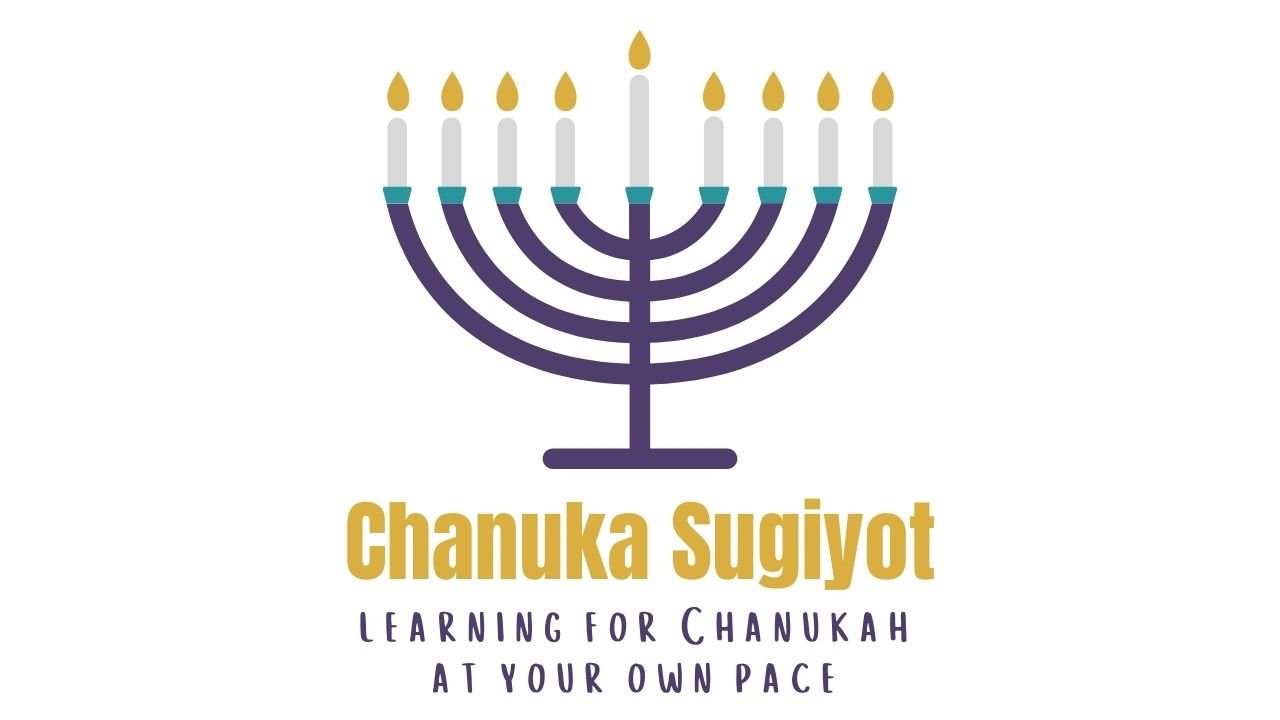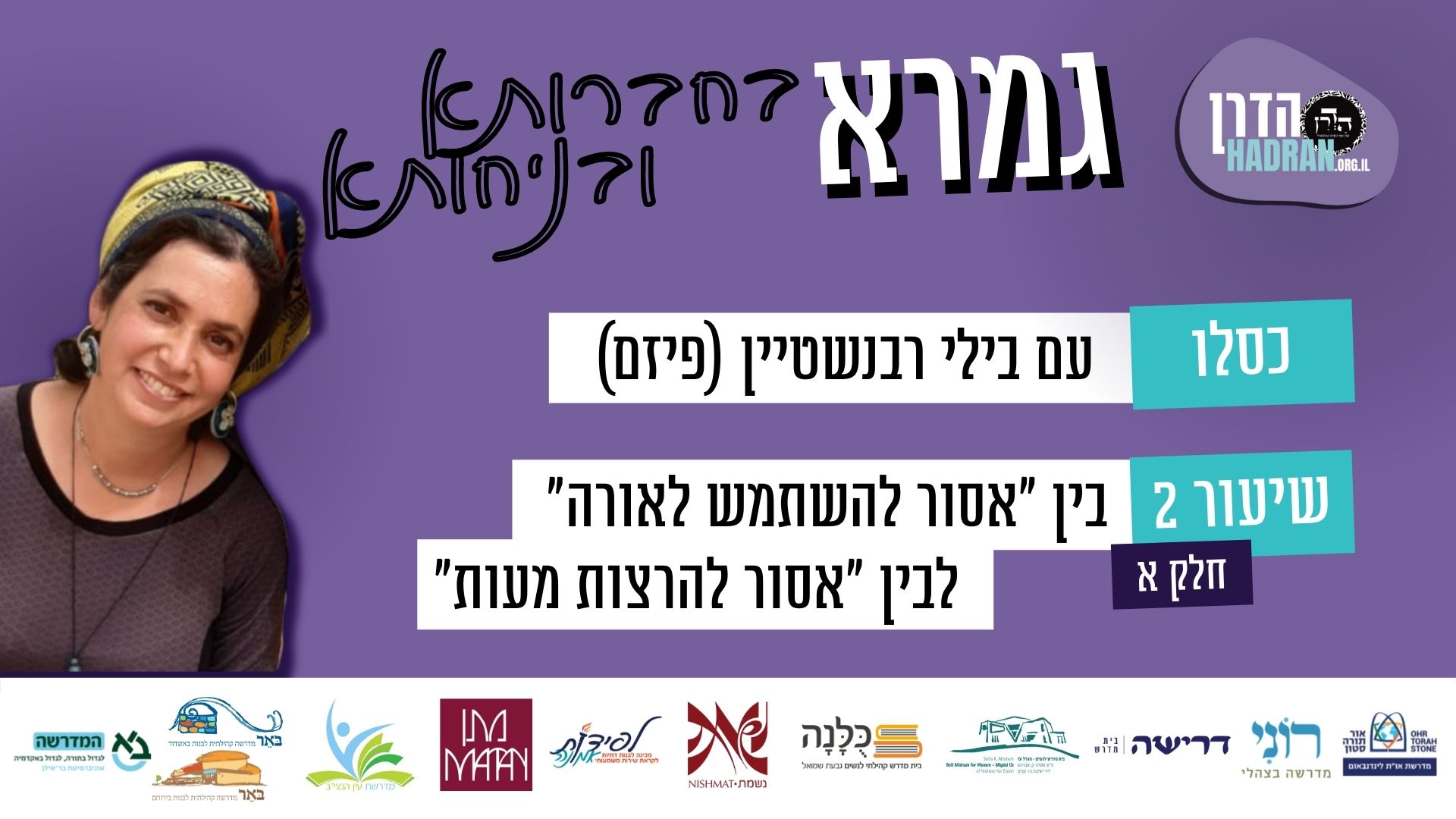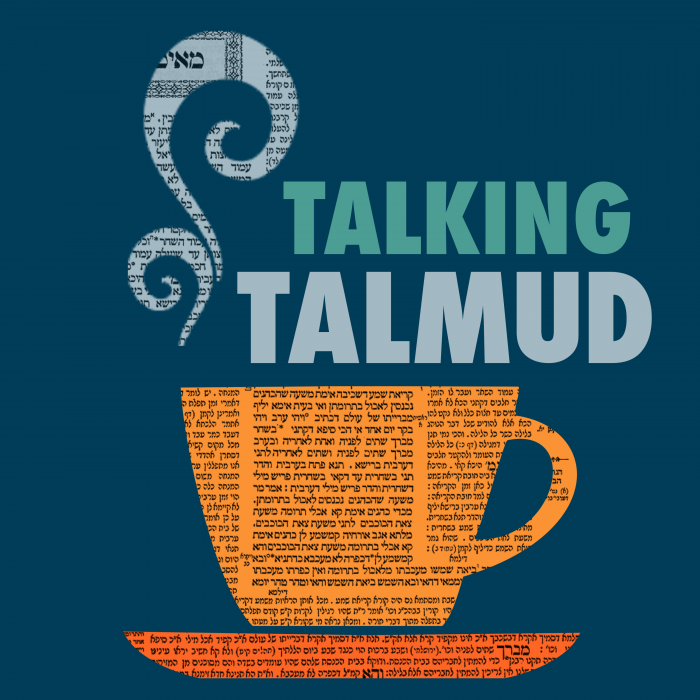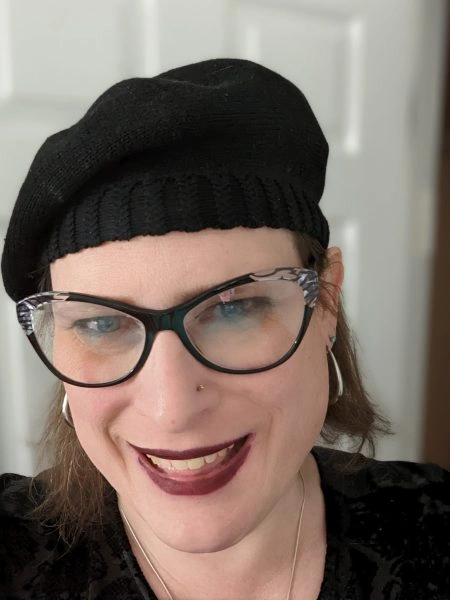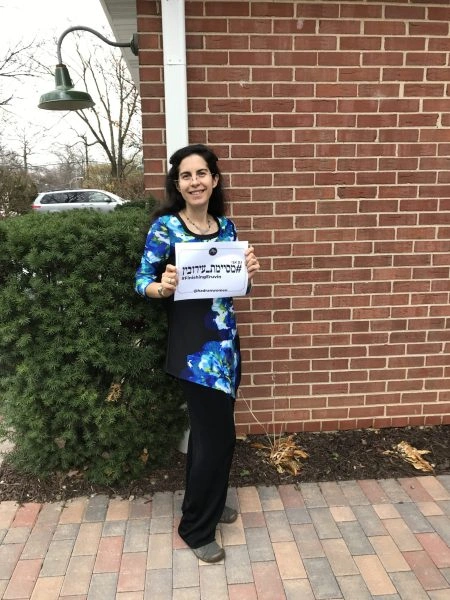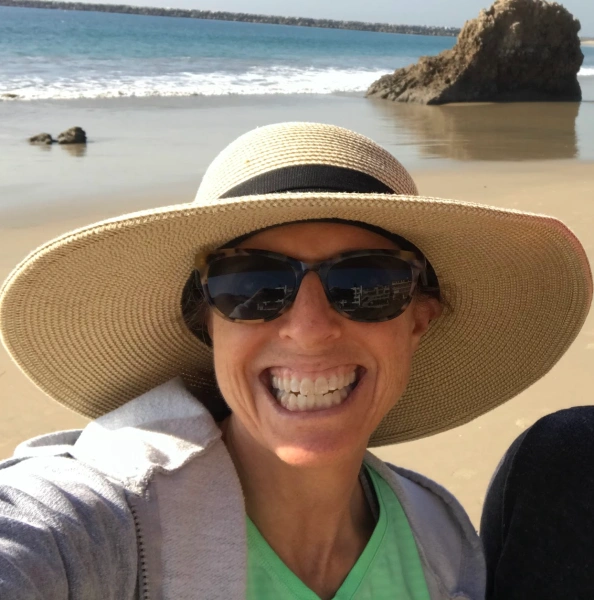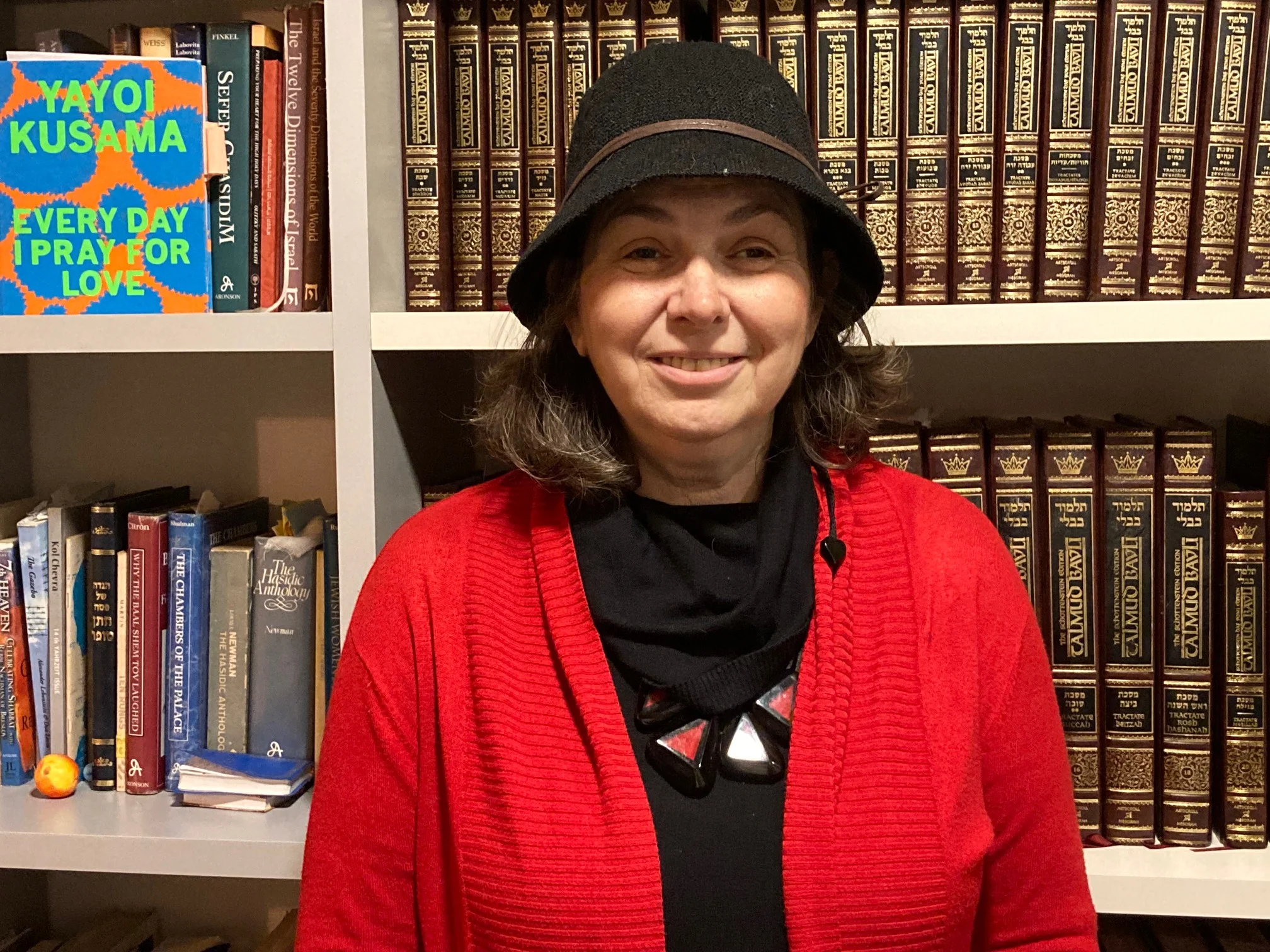Shabbat 21
לְמַאי נָפְקָא מִינַּהּ? לְמִקָּח וּמִמְכָּר.
The Gemara asks: What is the practical difference that emerges from that which Rami bar Avin taught? The Gemara explains: Its significance is with regard to buying and selling. One who buys tar can insist upon receiving the by-product of pitch and no other material. The same is true with regard to wax and honey.
תָּנוּ רַבָּנַן: כׇּל אֵלּוּ שֶׁאָמְרוּ אֵין מַדְלִיקִין בָּהֶן בְּשַׁבָּת, אֲבָל עוֹשִׂין מֵהֶן מְדוּרָה — בֵּין לְהִתְחַמֵּם כְּנֶגְדָּהּ בֵּין לְהִשְׁתַּמֵּשׁ לְאוֹרָהּ, בֵּין עַל גַּבֵּי קַרְקַע, בֵּין עַל גַּבֵּי כִּירָה. וְלֹא אָסְרוּ אֶלָּא לַעֲשׂוֹת מֵהֶן פְּתִילָה לַנֵּר בִּלְבַד.
The Sages taught in the Tosefta: With regard to all of those materials about which they said that one may not light the lamp with them on Shabbat; however, one may use them ab initio to make a bonfire. One may do so both to warm himself opposite it and to utilize its light, and he may ignite it both on the ground and on a stove. They prohibited using them only to make a wick for an oil lamp.
וְלֹא בְּשֶׁמֶן קִיק וְכוּ׳. מַאי שֶׁמֶן קִיק? אָמַר שְׁמוּאֵל: שְׁאֵילְתִּינְהוּ לְכֹל נָחוֹתֵי יַמָּא, וַאֲמַרוּ לִי: עוֹף אֶחָד יֵשׁ בִּכְרַכֵּי הַיָּם וְקִיק שְׁמוֹ. רַב יִצְחָק בְּרֵיהּ דְּרַב יְהוּדָה אָמַר: מִשְׁחָא דְּקָאזָא. רֵישׁ לָקִישׁ אָמַר: קִיקָיוֹן דְּיוֹנָה. אָמַר רַבָּה בַּר בַּר חָנָה: לְדִידִי חֲזִי לִי קִיקָיוֹן דְּיוֹנָה, וְלִצְלוּלִיבָא דָּמֵי וּמִדֻּפְשְׁקֵי רָבֵי, וְעַל פּוּם חַנְוָתָא מַדְלָן יָתֵיהּ, וּמִפַּרְצִידוֹהִי עָבְדִי מִשְׁחָא, וּבְעַנְפוֹהִי נָיְיחָן כׇּל בְּרִיחֵי דְמַעְרְבָא.
And we learned in the mishna that one may not light the Shabbat lamp with kik oil. The Gemara asks: What is kik oil? Shmuel said: I asked all the seafarers, and they said to me that there is a bird in the cities on the sea coast, and kik is its name. Kik oil is produced from that bird. Rav Yitzḥak, son of Rav Yehuda, said: This is referring to cotton oil. Reish Lakish said: It is the oil made from the seed of a plant like the castor plant [kikayon] of Jonah. Rabba bar bar Ḥana said: I have seen the species of the castor plant of Jonah, and it is similar to the ricinus tree and it grows in swamps, and they place it at the entrance of shops for shade, and they produce oil from its seeds, and all the sick people of the West, Eretz Yisrael, rest beneath its branches.
אָמַר רַבָּה: פְּתִילוֹת שֶׁאָמְרוּ חֲכָמִים אֵין מַדְלִיקִין בָּהֶן בְּשַׁבָּת, מִפְּנֵי שֶׁהָאוּר מְסַכְסֶכֶת בָּהֶן. שְׁמָנִים שֶׁאָמְרוּ חֲכָמִים אֵין מַדְלִיקִין בָּהֶן, מִפְּנֵי שֶׁאֵין נִמְשָׁכִין אַחַר הַפְּתִילָה.
Rabba said: Those wicks about which the Sages said one may not light with them on Shabbat, the reason is: Because the fire flickers on them. It sputters on the wick and does not burn well. Those oils with which the Sages said that one may not light on Shabbat, the reason is: Because they are not drawn effectively by the wick.
בְּעָא מִינֵּיהּ אַבָּיֵי מֵרַבָּה: שְׁמָנִים שֶׁאָמְרוּ חֲכָמִים אֵין מַדְלִיקִין בָּהֶן בְּשַׁבָּת, מַהוּ שֶׁיִּתֵּן לְתוֹכָן שֶׁמֶן כׇּל שֶׁהוּא וְיַדְלִיק? מִי גָּזְרִינַן דִּילְמָא אָתֵי לְאַדְלוֹקֵי בְּעֵינַיְיהוּ, אוֹ לָא? אֲמַר לֵיהּ: אֵין מַדְלִיקִין. מַאי טַעְמָא? לְפִי שֶׁאֵין מַדְלִיקִין.
Abaye raised a dilemma before Rabba: Those oils with which the Sages said one may not light on Shabbat, what is the ruling? May one, ab initio, add to them any amount of oil with which it is permissible to light and light with that mixture? The sides of the dilemma are: Do we issue a decree lest one come to light these oils in their natural form, without mixing them with permissible oils? Or no, that possibility is not a source of concern? Rabba said to him: One may not light that mixture. What is the reason for this? The reason is because the halakha is that one may not light (Arukh).
אֵיתִיבֵיהּ: כָּרַךְ דָּבָר שֶׁמַּדְלִיקִין בּוֹ עַל גַּבֵּי דָּבָר שֶׁאֵין מַדְלִיקִין בּוֹ — אֵין מַדְלִיקִין בּוֹ. אָמַר רַבָּן שִׁמְעוֹן בֶּן גַּמְלִיאֵל: שֶׁל בֵּית אַבָּא הָיוּ כּוֹרְכִין פְּתִילָה עַל גַּבֵּי אֱגוֹז וּמַדְלִיקִין. קָתָנֵי מִיהַת מַדְלִיקִין!
Abaye raised an objection to Rabba’s opinion from that which was taught in the Tosefta: One who wrapped a material with which one may light around a material with which one may not light, may not light with the bound wick. Rabban Shimon ben Gamliel said: In the ancestral house of my father, they would wrap a wick with which one is permitted to light around a nut, and that was how they would light. In any case, it is teaching that, according to Rabban Shimon ben Gamliel, one may light. Apparently, one is permitted to light with a combination of permitted and prohibited wicks.
אֲמַר לֵיהּ: אַדְּמוֹתְבַתְּ לֵיהּ מִדְּרַבָּן שִׁמְעוֹן בֶּן גַּמְלִיאֵל, סַיְּיעֵיהּ מִדְּתַנָּא קַמָּא! הָא לָא קַשְׁיָא: ״מַעֲשֶׂה רַב״. מִכׇּל מָקוֹם קַשְׁיָא: מַאי לָאו, לְהַדְלִיק? לָא, לְהַקְפּוֹת. אִי לְהַקְפּוֹת, מַאי טַעְמָא דְּתַנָּא קַמָּא? כּוּלָּהּ רַבָּן שִׁמְעוֹן בֶּן גַּמְלִיאֵל הִיא וְחַסּוֹרֵי מִיחַסְּרָא, וְהָכִי קָתָנֵי: כָּרַךְ דָּבָר שֶׁמַּדְלִיקִין בּוֹ עַל גַּבֵּי דָּבָר שֶׁאֵין מַדְלִיקִין בּוֹ — אֵין מַדְלִיקִין בּוֹ. בַּמֶּה דְּבָרִים אֲמוּרִים — לְהַדְלִיק, אֲבָל לְהַקְפּוֹת — מוּתָּר, שֶׁרַבָּן שִׁמְעוֹן בֶּן גַּמְלִיאֵל אוֹמֵר: שֶׁל בֵּית אַבָּא הָיוּ כּוֹרְכִין פְּתִילָה עַל גַּבֵּי אֱגוֹז.
Rabba said to him: Before you raise an objection to my opinion from the statement of Rabban Shimon ben Gamliel, support it from the statement of the first tanna, who said that it is prohibited to light in that case. The Gemara answers: This is not difficult, as it is preferable to challenge from the statement of Rabban Gamliel with regard to the custom in his father’s house. There is a principle that proof cited from an action is great, i.e., a practical precedent is more substantial than a theoretical halakha. Nevertheless, the difficulty from the statement of Rabban Shimon ben Gamliel remains: Is he not speaking of a case where he combined the wick and the nut to light them together? If so, one is permitted to combine the prohibited and the permitted. The Gemara answers: No, it is speaking in a case where he combined them to float the wick on the oil with the help of the nut. The Gemara asks: If it is speaking only with regard to a case of floating the wick, what is the reason that the first tanna prohibits doing so? The Gemara answers: The entire baraita is the opinion of Rabban Shimon ben Gamliel, and it is incomplete, and it teaches the following: One who wrapped a material with which one may light around a material with which one may not light, may not light with it. In what case is this statement said? When he combines the materials to light them together. However, if he utilizes that with which one may not light merely in order to float the wick, it is permitted, as we learned that Rabban Shimon ben Gamliel says: In the ancestral house of my father, they would wrap a wick with which one is permitted to light around a nut. That was how they would light.
אִינִי?! וְהָאָמַר רַב בְּרוֹנָא אָמַר רַב: חֵלֶב מְהוּתָּךְ וְקִרְבֵי דָגִים שֶׁנִּמּוֹחוּ, אָדָם נוֹתֵן לְתוֹכָן שֶׁמֶן כׇּל שֶׁהוּא וּמַדְלִיק? הָנֵי מִימַּשְׁכִי בְּעֵינַיְיהוּ, וְהָנֵי לָא מִימַּשְׁכִי בְּעֵינַיְיהוּ. וּגְזַרוּ רַבָּנַן עַל חֵלֶב מְהוּתָּךְ מִשּׁוּם חֵלֶב שֶׁאֵינוֹ מְהוּתָּךְ, וְעַל קִרְבֵי דָגִים שֶׁנִּמּוֹחוּ מִשּׁוּם קִרְבֵי דָגִים שֶׁלֹּא נִמּוֹחוּ. וְלִיגְזוֹר נָמֵי חֵלֶב מְהוּתָּךְ וְקִרְבֵי דָגִים שֶׁנִּמּוֹחוּ שֶׁנָּתַן לְתוֹכָן שֶׁמֶן מִשּׁוּם חֵלֶב מְהוּתָּךְ וְקִרְבֵי דָגִים שֶׁנִּמּוֹחוּ שֶׁלֹּא נָתַן לְתוֹכָן שֶׁמֶן! הִיא גּוּפָהּ, גְּזֵירָה, וַאֲנַן נֵיקוּם וְנִיגְזוֹר גְּזֵירָה לִגְזֵירָה?!
In any case, to this point the conclusion is that one may not light with a mixture of permitted and prohibited oils. The Gemara asks: Is that so? Didn’t Rav Beruna say that Rav said: With regard to molten fat or fish innards that dissolved and became like oil, a person may place any amount of oil fit for lighting into it and light. Apparently, one may light with a mixture of permitted and prohibited oils. Rabba answers: These, the fat and the fish innards, are drawn by the wick even in their natural state, and those, the prohibited oils, are not drawn in their natural state. Originally, the Sages issued a decree to prohibit molten fat due to unmolten fat and to prohibit dissolved fish innards due to undissolved fish innards; however, the Sages did not issue a decree in a case where one added to them any amount of oil suitable for lighting, and permitted lighting with it. The Gemara asks: Let them also issue a decree to prohibit molten fat and dissolved fish innards to which he added oil due to molten fat and dissolved fish innards to which he did not add permitted oil. The Gemara rejects this: That prohibition with regard to molten fat and dissolved fish innards itself is based on a decree. And will we arise and issue one decree to prevent violation of another decree? The Sages do not issue decrees under those circumstances. Therefore, there is no reason to prohibit their use.
תָּנֵי רָמֵי בַּר חָמָא: פְּתִילוֹת וּשְׁמָנִים שֶׁאָמְרוּ חֲכָמִים אֵין מַדְלִיקִין בָּהֶן בְּשַׁבָּת — אֵין מַדְלִיקִין בָּהֶן בַּמִּקְדָּשׁ, מִשּׁוּם שֶׁנֶּאֱמַר: ״לְהַעֲלוֹת נֵר תָּמִיד״. הוּא תָּנֵי לַהּ, וְהוּא אָמַר לַהּ — כְּדֵי שֶׁתְּהֵא שַׁלְהֶבֶת עוֹלָה מֵאֵילֶיהָ, וְלֹא שֶׁתְּהֵא עוֹלָה עַל יְדֵי דָּבָר אַחֵר.
Rami bar Ḥama taught a baraita: Those wicks and oils, which the Sages said one may not light with them on Shabbat, one may not light with them in the Temple either because it is stated with regard to the Temple candelabrum: “And you shall command the children of Israel, that they bring unto you pure olive oil beaten for the light, to cause a lamp to burn continually” (Exodus 27:20). Rami bar Ḥama taught that baraita and he also said its explanation: What is the proof from the verse? One may interpret the verse homiletically: The requirement is to light the candelabrum so that the flame ascends of itself when it is kindled, and not that it ascends by means of something else, i.e., adjusting the wick after it was lit.
תְּנַן: מִבְּלָאֵי מִכְנְסֵי כֹּהֲנִים וּמֵהֶמְיָנֵיהֶם הָיוּ מַפְקִיעִין, וּמֵהֶן מַדְלִיקִין. שִׂמְחַת בֵּית הַשּׁוֹאֵבָה שָׁאנֵי.
We learned in a mishna: They would unravel the threads of the tattered trousers of the priests and their belts in order to make wicks from them, and from those same wicks they would light at the Celebration of Drawing Water. There was wool in the belts of the priests. It is said that their belts were made from, among other things, tekhelet, which in the Bible refers to dyed wool. Apparently, one may light with a mixture that includes a wick unsuitable for lighting. The Gemara answers: The Celebration of Drawing Water is different, as in that celebration, they did not light the Temple candelabrum. They lit special lanterns made specifically for that purpose and were not stringent with regard to the wicks placed in them.
תָּא שְׁמַע, דְּתָנֵי רַבָּה בַּר מַתְנָה: בִּגְדֵי כְהוּנָּה שֶׁבָּלוּ מַפְקִיעִין אוֹתָן, וּמֵהֶן הָיוּ עוֹשִׂין פְּתִילוֹת לַמִּקְדָּשׁ. מַאי לָאו, דְּכִלְאַיִם? לָא, דְּבוּץ.
Come and hear a related question from that which Rabba bar Mattana taught: Priestly garments that were tattered, they would unravel them into threads from which they would make wicks for the Temple. Is this not also referring to garments made of diverse kinds, like the sashes of the priests that were made of a mixture of wool and linen? The Gemara answers: No, these wicks were made from linen garments alone.
אָמַר רַב הוּנָא: פְּתִילוֹת וּשְׁמָנִים שֶׁאָמְרוּ חֲכָמִים אֵין מַדְלִיקִין בָּהֶן בְּשַׁבָּת, אֵין מַדְלִיקִין בָּהֶן בַּחֲנוּכָּה, בֵּין בְּשַׁבָּת בֵּין בַּחוֹל. אָמַר רָבָא: מַאי טַעְמָא דְּרַב הוּנָא? — קָסָבַר: כָּבְתָה זָקוּק לָהּ, וּמוּתָּר לְהִשְׁתַּמֵּשׁ לְאוֹרָהּ. וְרַב חִסְדָּא אָמַר: מַדְלִיקִין בָּהֶן בַּחוֹל, אֲבָל לֹא בְּשַׁבָּת. קָסָבַר: כָּבְתָה
Rav Huna said: Those wicks and oils with which the Sages said that one may not light the lamp on Shabbat, one may not light the lamp with them on Hanukkah either; both when it falls on Shabbat and when it falls during the week. Rava said: What is the reason for Rav Huna’s statement? He holds that if the Hanukkah light becomes extinguished, even though one lit it properly, one is bound to attend to it and relight it so that it will burn properly. Therefore, one must ensure that the wick burns properly from the outset. And utilizing the light of the Hanukkah lamp is permitted during the week. Consequently, in order to prevent him from inadvertently sinning on Shabbat, he must ensure from the outset that the wick burns well, lest he come to adjust the flame on Shabbat. Those wicks and oils do not burn well at all. And Rav Ḥisda said: Those same oils and wicks with which the Sages prohibited to light on Shabbat, one may light with them on Hanukkah during the week, but not on Shabbat. He holds that if the Hanukkah light is extinguished
אֵין זָקוּק לָהּ, וּמוּתָּר לְהִשְׁתַּמֵּשׁ לְאוֹרָהּ. אָמַר רַבִּי זֵירָא אָמַר רַב מַתְנָה, וְאָמְרִי לַהּ אָמַר רַבִּי זֵירָא אָמַר רַב: פְּתִילוֹת וּשְׁמָנִים שֶׁאָמְרוּ חֲכָמִים אֵין מַדְלִיקִין בָּהֶן בְּשַׁבָּת, מַדְלִיקִין בָּהֶן בַּחֲנוּכָּה, בֵּין בַּחוֹל בֵּין בְּשַׁבָּת. אָמַר רַבִּי יִרְמְיָה: מַאי טַעְמָא דְּרַב? — קָסָבַר: כָּבְתָה אֵין זָקוּק לָהּ, וְאָסוּר לְהִשְׁתַּמֵּשׁ לְאוֹרָהּ.
one is not bound to attend to it. Therefore, there is no reason to make certain from the outset to light it with materials that burn well, as even if it is extinguished, he is not required to relight it. However, he also holds that it is permitted to use its light. As a result, he must ensure that the wick burns well on Shabbat; if not, he is liable to come to adjust the flame in order to use its light. The third opinion is that which Rabbi Zeira said that Rav Mattana said, and others say that Rabbi Zeira said that Rav said: The wicks and oils with which the Sages said one may not light on Shabbat, one may, nevertheless, light with them on Hanukkah, both during the week and on Shabbat. Rabbi Yirmeya said: What is Rav’s reason? He holds that if it is extinguished, one is not bound to attend to it and relight it, and it is prohibited to use its light. Therefore, even on Shabbat, there is no concern lest he come to adjust the wick, as it is prohibited to utilize its light.
אַמְרוּהָ רַבָּנַן קַמֵּיהּ דְּאַבָּיֵי מִשְּׁמֵיהּ דְּרַבִּי יִרְמְיָה, וְלָא קַבְּלַהּ. כִּי אֲתָא רָבִין אַמְרוּהָ רַבָּנַן קַמֵּיהּ דְּאַבָּיֵי מִשְּׁמֵיהּ דְּרַבִּי יוֹחָנָן, וְקַבְּלַהּ. אֲמַר: אִי זְכַאי, גְּמִירְתַּיהּ לִשְׁמַעְתֵּיהּ מֵעִיקָּרָא. וְהָא גַּמְרַהּ! נָפְקָא מִינַּהּ לְגִירְסָא דְיַנְקוּתָא.
The Gemara relates that the Sages said this halakha before Abaye in the name of Rabbi Yirmeya and he did not accept it, as he did not hold Rabbi Yirmeya in high regard. However, subsequently, when Ravin came from Eretz Yisrael to Babylonia, the Sages said this halakha before Abaye in the name of Rabbi Yoḥanan, and he accepted it. Then Abaye said regretfully: Had I merited, I would have learned this halakha from the outset. The Gemara wonders: Didn’t he ultimately learn it and accept it? What difference does it make from whom and at what point he learned it? The Gemara answers: The practical difference is with regard to knowledge acquired in one’s youth, which is better remembered.
וְכָבְתָה אֵין זָקוּק לָהּ? וּרְמִינְהוּ: מִצְוָתָהּ מִשֶּׁתִּשְׁקַע הַחַמָּה עַד שֶׁתִּכְלֶה רֶגֶל מִן הַשּׁוּק. מַאי לָאו, דְּאִי כָּבְתָה הֲדַר מַדְלֵיק לָהּ! לָא, דְּאִי לָא אַדְלֵיק — מַדְלֵיק. וְאִי נָמֵי לְשִׁיעוּרַהּ.
With regard to the opinion that one need not rekindle the Hanukkah light if it is extinguished, the Gemara asks: And is it true that if the Hanukkah light is extinguished one is not bound to attend to it? The Gemara raises a contradiction from that which was taught in a baraita: The mitzva of kindling the Hanukkah lights is from sunset until traffic in the marketplace ceases. Does that not mean that if the light is extinguished, he must rekindle it so that it will remain lit for the duration of that period? The Gemara answers: No, the baraita can be understood otherwise: That if one did not yet light at sunset, he may still light the Hanukkah lights until traffic ceases. Alternatively, one could say that this is referring to the matter of its measure. One must prepare a wick and oil sufficient to burn for the period lasting from sunset until traffic ceases. If he did so, even if the light is extinguished beforehand, he need not relight it.
עַד שֶׁתִּכְלֶה רֶגֶל מִן הַשּׁוּק. וְעַד כַּמָּה? אָמַר רַבָּה בַּר בַּר חָנָה אָמַר רַבִּי יוֹחָנָן: עַד דְּכָלְיָא רִיגְלָא דְתַרְמוֹדָאֵי.
The expression until traffic in the marketplace ceases is mentioned here, and the Gemara asks: Until when exactly is this time? Rabba bar bar Ḥana said that Rabbi Yoḥanan said: Until the traffic of the people of Tadmor [tarmoda’ei] ceases. They sold kindling wood and remained in the marketplace later than everyone else. People who discovered at sunset that they had exhausted their wood supply could purchase wood from them.
תָּנוּ רַבָּנַן: מִצְוַת חֲנוּכָּה, נֵר אִישׁ וּבֵיתוֹ. וְהַמְהַדְּרִין, נֵר לְכׇל אֶחָד וְאֶחָד. וְהַמְהַדְּרִין מִן הַמְהַדְּרִין, בֵּית שַׁמַּאי אוֹמְרִים: יוֹם רִאשׁוֹן מַדְלִיק שְׁמֹנָה, מִכָּאן וְאֵילָךְ פּוֹחֵת וְהוֹלֵךְ. וּבֵית הִלֵּל אוֹמְרִים: יוֹם רִאשׁוֹן מַדְלִיק אַחַת, מִכָּאן וְאֵילָךְ מוֹסִיף וְהוֹלֵךְ.
The Sages taught in a baraita: The basic mitzva of Hanukkah is each day to have a light kindled by a person, the head of the household, for himself and his household. And the mehadrin, i.e., those who are meticulous in the performance of mitzvot, kindle a light for each and every one in the household. And the mehadrin min hamehadrin, who are even more meticulous, adjust the number of lights daily. Beit Shammai and Beit Hillel disagree as to the nature of that adjustment. Beit Shammai say: On the first day one kindles eight lights and, from there on, gradually decreases the number of lights until, on the last day of Hanukkah, he kindles one light. And Beit Hillel say: On the first day one kindles one light, and from there on, gradually increases the number of lights until, on the last day, he kindles eight lights.
אָמַר עוּלָּא: פְּלִיגִי בַּהּ תְּרֵי אָמוֹרָאֵי בְּמַעְרְבָא, רַבִּי יוֹסֵי בַּר אָבִין וְרַבִּי יוֹסֵי בַּר זְבִידָא. חַד אָמַר טַעְמָא דְּבֵית שַׁמַּאי כְּנֶגֶד יָמִים הַנִּכְנָסִין, וְטַעְמָא דְּבֵית הִלֵּל כְּנֶגֶד יָמִים הַיּוֹצְאִין. וְחַד אָמַר טַעְמָא דְּבֵית שַׁמַּאי כְּנֶגֶד פָּרֵי הַחַג, וְטַעְמָא דְּבֵית הִלֵּל דְּמַעֲלִין בַּקֹּדֶשׁ וְאֵין מוֹרִידִין.
Ulla said: There were two amora’im in the West, Eretz Yisrael, who disagreed with regard to this dispute, Rabbi Yosei bar Avin and Rabbi Yosei bar Zevida. One said that the reason for Beit Shammai’s opinion is that the number of lights corresponds to the incoming days, i.e., the future. On the first day, eight days remain in Hanukkah, one kindles eight lights, and on the second day seven days remain, one kindles seven, etc. The reason for Beit Hillel’s opinion is that the number of lights corresponds to the outgoing days. Each day, the number of lights corresponds to the number of the days of Hanukkah that were already observed. And one said that the reason for Beit Shammai’s opinion is that the number of lights corresponds to the bulls of the festival of Sukkot: Thirteen were sacrificed on the first day and each succeeding day one fewer was sacrificed (Numbers 29:12–31). The reason for Beit Hillel’s opinion is that the number of lights is based on the principle: One elevates to a higher level in matters of sanctity and one does not downgrade. Therefore, if the objective is to have the number of lights correspond to the number of days, there is no alternative to increasing their number with the passing of each day.
אָמַר רַבָּה בַּר בַּר חָנָה אָמַר רַבִּי יוֹחָנָן: שְׁנֵי זְקֵנִים הָיוּ בְּצַיְדָּן. אֶחָד עָשָׂה כְּבֵית שַׁמַּאי וְאֶחָד עָשָׂה כְּדִבְרֵי בֵּית הִלֵּל. זֶה נוֹתֵן טַעַם לִדְבָרָיו כְּנֶגֶד פָּרֵי הַחַג, וְזֶה נוֹתֵן טַעַם לִדְבָרָיו דְּמַעֲלִין בַּקֹּדֶשׁ וְאֵין מוֹרִידִין.
Rabba bar bar Ḥana said that Rabbi Yoḥanan said: There were two Elders in Sidon, and one of them acted in accordance with the opinion of Beit Shammai, and one of them acted in accordance with the opinion of Beit Hillel. Each provided a reason for his actions: One gave a reason for his actions: The number of lights corresponds to the bulls of the Festival. And one gave a reason for his actions: The number of lights is based on the principle: One elevates to a higher level in matters of sanctity and one does not downgrade.
תָּנוּ רַבָּנַן: נֵר חֲנוּכָּה מִצְוָה לְהַנִּיחָהּ עַל פֶּתַח בֵּיתוֹ מִבַּחוּץ. אִם הָיָה דָּר בַּעֲלִיָּיה — מַנִּיחָהּ בַּחַלּוֹן הַסְּמוּכָה לִרְשׁוּת הָרַבִּים. וּבִשְׁעַת הַסַּכָּנָה — מַנִּיחָהּ עַל שֻׁלְחָנוֹ וְדַיּוֹ.
The Sages taught in a baraita: It is a mitzva to place the Hanukkah lamp at the entrance to one’s house on the outside, so that all can see it. If he lived upstairs, he places it at the window adjacent to the public domain. And in a time of danger, when the gentiles issued decrees to prohibit kindling lights, he places it on the table and that is sufficient to fulfill his obligation.
אָמַר רָבָא: צָרִיךְ נֵר אַחֶרֶת לְהִשְׁתַּמֵּשׁ לְאוֹרָהּ. וְאִי אִיכָּא מְדוּרָה — לֹא צָרִיךְ. וְאִי אָדָם חָשׁוּב הוּא — אַף עַל גַּב דְּאִיכָּא מְדוּרָה צָרִיךְ נֵר אַחֶרֶת.
Rava said: One must kindle another light in addition to the Hanukkah lights in order to use its light, as it is prohibited to use the light of the Hanukkah lights. And if there is a bonfire, he need not light an additional light, as he can use the light of the bonfire. However, if he is an important person, who is unaccustomed to using the light of a bonfire, even though there is a bonfire, he must kindle another light.
מַאי חֲנוּכָּה? דְּתָנוּ רַבָּנַן: בְּכ״ה בְּכִסְלֵיו יוֹמֵי דַחֲנוּכָּה תְּמָנְיָא אִינּוּן דְּלָא לְמִסְפַּד בְּהוֹן וּדְלָא לְהִתְעַנּוֹת בְּהוֹן. שֶׁכְּשֶׁנִּכְנְסוּ יְוָוֽנִים לַהֵיכָל טִמְּאוּ כׇּל הַשְּׁמָנִים שֶׁבַּהֵיכָל. וּכְשֶׁגָּבְרָה מַלְכוּת בֵּית חַשְׁמוֹנַאי וְנִצְּחוּם, בָּדְקוּ וְלֹא מָצְאוּ אֶלָּא פַּךְ אֶחָד שֶׁל שֶׁמֶן שֶׁהָיָה מוּנָּח בְּחוֹתָמוֹ שֶׁל כֹּהֵן גָּדוֹל, וְלֹא הָיָה בּוֹ אֶלָּא לְהַדְלִיק יוֹם אֶחָד. נַעֲשָׂה בּוֹ נֵס וְהִדְלִיקוּ מִמֶּנּוּ שְׁמוֹנָה יָמִים. לְשָׁנָה אַחֶרֶת קְבָעוּם וַעֲשָׂאוּם יָמִים טוֹבִים בְּהַלֵּל וְהוֹדָאָה.
The Gemara asks: What is Hanukkah, and why are lights kindled on Hanukkah? The Gemara answers: The Sages taught in Megillat Ta’anit: On the twenty-fifth of Kislev, the days of Hanukkah are eight. One may not eulogize on them and one may not fast on them. What is the reason? When the Greeks entered the Sanctuary they defiled all the oils that were in the Sanctuary by touching them. And when the Hasmonean monarchy overcame them and emerged victorious over them, they searched and found only one cruse of oil that was placed with the seal of the High Priest, undisturbed by the Greeks. And there was sufficient oil there to light the candelabrum for only one day. A miracle occurred and they lit the candelabrum from it eight days. The next year the Sages instituted those days and made them holidays with recitation of hallel and special thanksgiving in prayer and blessings.
תְּנַן הָתָם: גֵּץ הַיּוֹצֵא מִתַּחַת הַפַּטִּישׁ וְיָצָא וְהִזִּיק — חַיָּיב. גָּמָל שֶׁטָּעוּן פִּשְׁתָּן וְהוּא עוֹבֵר בִּרְשׁוּת הָרַבִּים וְנִכְנְסָה פִּשְׁתָּנוֹ לְתוֹךְ הַחֲנוּת וְדָלְקָה בְּנֵרוֹ שֶׁל חֶנְוָנִי וְהִדְלִיק אֶת הַבִּירָה — בַּעַל הַגָּמָל חַיָּיב. הִנִּיחַ חֶנְוָנִי אֶת נֵרוֹ מִבְּחוּץ — חֶנְוָנִי חַיָּיב.
We learned there in a mishna with regard to damages: In the case of a spark that emerges from under a hammer, and went out of the artisan’s workshop, and caused damage, the one who struck the hammer is liable. Similarly, in the case of a camel that is laden with flax and it passed through the public domain, and its flax entered into a store, and caught fire from the storekeeper’s lamp, and set fire to the building, the camel owner is liable. Since his flax entered into another’s domain, which he had no permission to enter, all the damages were caused due to his negligence. However, if the storekeeper placed his lamp outside the store and it set fire to the flax, the storekeeper is liable, as he placed the lamp outside his domain where he had no right to place it.
רַבִּי יְהוּדָה אוֹמֵר: בְּנֵר חֲנוּכָּה — פָּטוּר. אָמַר רָבִינָא מִשּׁוּם דְּרַבָּה: זֹאת אוֹמֶרֶת נֵר חֲנוּכָּה מִצְוָה לְהַנִּיחָהּ בְּתוֹךְ עֲשָׂרָה. דְּאִי סָלְקָא דַּעְתָּךְ לְמַעְלָה מֵעֲשָׂרָה, לֵימָא לֵיהּ: הָיָה לָךְ לְהַנִּיחַ לְמַעְלָה מִגָּמָל וְרוֹכְבוֹ! וְדִילְמָא, אִי מַיטְּרְחָא לֵיהּ טוּבָא אָתֵי לְאִימְּנוֹעֵי מִמִּצְוָה.
Rabbi Yehuda says: If the flax was set on fire by the storekeeper’s Hanukkah lamp that he placed outside the entrance to his store, he is not liable, as in that case, it is permitted for the storekeeper to place his lamp outside. Ravina said in the name of Rabba: That is to say that it is a mitzva to place the Hanukkah lamp within ten handbreadths of the ground. As if it should enter your mind to say that he may place it above ten handbreadths, why is the storekeeper exempt? Let the camel owner say to the storekeeper: You should have placed the lamp above the height of a camel and its rider, and then no damage would have been caused. By failing to do so, the storekeeper caused the damage, and the camel owner should not be liable. The Gemara rejects this: And perhaps one is also permitted to place the Hanukkah lamp above ten handbreadths, and the reason Rabbi Yehuda exempted the storekeeper was due to concern for the observance of the mitzva of kindling Hanukkah lights. He held that if you burden one excessively, he will come to refrain from performing the mitzva of kindling Hanukkah lights. Since the storekeeper placed the Hanukkah lamp outside at the behest of the Sages, the storekeeper should not be required to take extra precautions.
אָמַר רַב כָּהֲנָא, דָּרֵשׁ רַב נָתָן בַּר מִנְיוֹמֵי מִשְּׁמֵיהּ דְּרַבִּי תַּנְחוּם:
With regard to the essence of the matter Rav Kahana said that Rav Natan bar Manyumi taught in the name of Rabbi Tanḥum:



